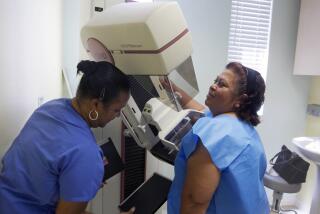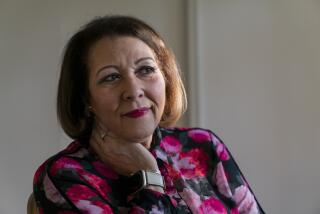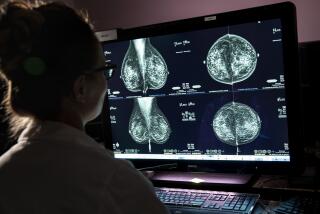Mammograms found to be less crucial in preventing deaths
- Share via
Recent advances in breast cancer awareness and treatment have made routine mammography less crucial in detecting cancer and mitigated its value in reducing deaths, researchers reported Wednesday.
Although the World Health Organization and U.S. authorities have found previously that mammography reduces deaths from breast cancer by about 25%, the new study in the New England Journal of Medicine determined that the death rate dropped by only 10% after the introduction of routine mammography in Norway.
The reduction was “far less than we expected,” said Dr. Mette Kalager, a surgeon at Oslo University Hospital and the study’s lead author. In fact, during the period covered by the study, the death rate among women over 70 — who did not undergo mammography but received the same care as younger women — dropped by 8%. That suggests that the benefit of mammography may have been as little as 2%, Kalager said.
In an editorial accompanying the report, Dr. H. Gilbert Welch of the Dartmouth Institute for Health Policy and Clinical Practice in Lebanon, N.H., called the reported benefit “disappointingly small.” But, he noted, “it is quite plausible that screening mammography was more effective in the past than it is now.”
As more tumors are discovered earlier because of increased awareness and more effective treatments are employed, Welch said, mammography becomes less valuable. Based on the new results, he said, 2,500 women would have to be screened for 10 years for one to avoid death from breast cancer. Meanwhile, at least 1,000 of those women would receive at least one false-positive result and five to 15 would be diagnosed and treated for a condition that was never going to bother them.
Dr. Otis W. Brawley, chief medical officer of the American Cancer Society, agreed that heightened awareness contributes to earlier detection of breast cancer, improving overall outcomes. Nonetheless, he said in a statement, “the total body of the science supports the fact that regular mammography is an important part of a woman’s preventive healthcare.”
The U.S. Preventive Services Task Force concluded last year that screening about 1,300 women ages 50 or older to save one life was beneficial, but that screening 1,900 in their 40s to save one life was not. An estimated 192,000 new cases of breast cancer are expected to be diagnosed in the United States this year, and the disease will cause about 40,000 deaths.
If the results from the Norwegian study are confirmed, mammography could soon be viewed more like PSA screening of men for prostate cancer. Major health groups no longer recommend routine PSA screening. Rather, they suggest that the decision to screen should be made after a consultation between physician and patient in which they discuss the benefits and the risks.
That could become the routine procedure for breast cancer as well, experts said.
For their study, Kalager and his colleagues took advantage of the fact that Norway, a country of 4.8 million people, has a government-funded health system and complete computerized medical records. In 1996, Norwegian authorities initiated a pilot mammography screening program in four of the country’s 19 counties, in which women between the ages of 50 and 60 were invited to undergo screening every two years. All 19 counties also had to develop multidisciplinary teams for treating breast cancer patients.
Beginning two years later and over a period of nine years, the screening program was extended to the remaining 15 counties. That allowed the researchers to analyze four groups: women who lived in counties where screening was conducted between 1996 and 2005, women who lived in counties where screening did not occur during that period, and two closely matched control groups from the years before screening began.
During the period of the study, the researchers identified 40,075 women who developed breast cancer. They found that the death rate was reduced by 7.2 deaths per 100,000 person-years in the screening group and by 4.8 deaths per 100,000 years in the non-screening group compared with the historical controls. That corresponds to a 10% decrease in mortality in the screening group.
Dr. Joanne Mortimer, a medical oncologist and director of women’s cancer programs at the City of Hope medical center in Duarte, noted that the United States does not — except in rare instances — have the same sort of multidisciplinary teams to treat breast cancer that are common in Norway and the rest of Europe. Given that difference, she added, mammography is likely to make a larger contribution to preventing deaths here.
Dr. Stephen Sener, a breast cancer surgeon at USC’s Keck School of Medicine and a former president of the American Cancer Society, also noted that although all women in the counties where screening programs were invited to join, only 77% did. And an unknown proportion of women in the counties without screening programs may have gotten mammograms from private sources. “The statistics are problematic from the get-go,” he said.
thomas.maugh@latimes.com






